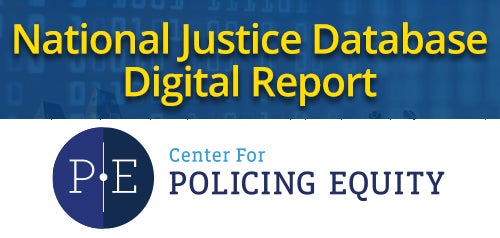Center for Policing Equity (CPE) Report

Overview
The Center for Policing Equity (CPE) partnered with the San Diego Police Department in 2019 to examine policing practices and behavior from 2016-Sept 2020 as a part of the National Justice Database (NJD) project. CPE examined the incidences of traffic stops, non-traffic stops, and use of force in order to:
- Identify any racial disparities in police interactions with people
- Determine if disparities were caused by inequitable practices or other factors
- Identify any attitudinal dispositions by officers or within the department that may be risk factors for inequitable practices
What makes this report different from other stop data reports that have been compiled using SDPD data?
The Center for Policing Equity’s analysis of SDPD data differs from other reports, such as those compiled by San Diego State University, Campaign Zero, and the San Diego Union-Tribune, among others, in three ways:
- The data used for the analysis is more robust due to the passage of the Racial and Identity Profiling Act (RIPA) that requires greater data collection by officers in the field since some of the other reports were released, and it included a larger number of stops than other data reports.
- It takes into account both internal and external factors in its findings that could contribute to disparities in policing practices. Internal factors include policies and procedures, units that contribute to a high portion of stops or implicit and explicit biases of officers. External factors considered in the analysis include accounting for crime rates, poverty rates and neighborhood demographics.
- It provides a companion page for SDPD leadership with recommendations for how to use this data to review police policies and practices through the scope of understanding that both internal and external factors impact changes in addressing disparities.
What does it mean if this analysis finds evidence of racial disparities?
Disparities in rates of police contact and the outcomes of this contact mean that racial groups in a community have different experiences of policing. When certain groups experience more frequent police contact, they are also exposed to an increased likelihood of further involvement in the justice system.
Racial disparities are important to measure because they shed light on specific sources of frustration and the risk of harmful outcomes in communities—an essential step in identifying effective reforms. But disparities do not necessarily indicate that police officers have engaged in biased or discriminatory behavior toward different racial groups. The NJD framework described below examines how factors outside of a department’s direct control (such as poverty and crime rates in a neighborhood) may contribute to observed disparities.
By accounting for external factors, it is possible to infer which portions of a disparity are likely related to factors within a department’s control, like officer behavior, as well as departmental policies and practices.
What factors might contribute to observed racial disparities?
The NJD analytic framework—a structure for collecting and interpreting the data used in these analyses—aims to distinguish among five broad types of explanations for racial disparities in policing:
- Individual characteristics or behaviors: Attributes or behaviors of individual community members may lead to a greater risk of interaction with law enforcement. Such behaviors and attributes may include mental health challenges, homelessness, or participation in criminal activity.
- Community characteristics: Neighborhood conditions, such as poverty or high crime rates, may result in higher rates of interaction with law enforcement.
- Individual officer characteristics or behaviors: Some officers may view members of certain communities with a higher level of suspicion, resulting in a disproportionate rate of stops or more punitive outcome of the stop for these people.
- Departmental culture, law, or policy: Institutional policies, practices, or norms may increase law enforcement contact with some members of the population more than others. For example, officers may be deployed to patrol some communities more intensively than others. Moreover, police departments may be constrained by federal, state, or local laws that may contribute to disparate interactions with people and communities.
- Relationships between communities and police: Mistrust of law enforcement can reduce community members’ willingness to cooperate with police. Similarly, a sense that communities do not trust or respect police may cause officers to feel unsafe or defensive in encounters with members of those communities.

